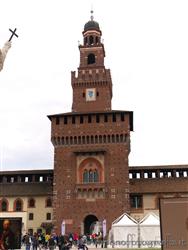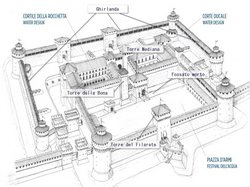|
Sforza Castle
|
|
|
Show an other treasure of art and history in Milan:
|
 Mostly represented styles: Gothic - Renaissance - Neogothic Mostly represented styles: Gothic - Renaissance - Neogothic
Photo captions (top to bottom from left to right):
1. The Ponticella, commissioned by Ludovico il Moro, and according to a tradition designed by Bramante, is an airy building above the moat, consisting of a porch and three rooms. 2.Entrance of the castle on the side of the Sempione Park 3. The Bona Tower4. Remains of the Ghirlanda and of a connecting bridge 5. One of the two circular towers on the side toward the city center 6. Coat of arms of the Sforza 7. Courtyard Ducale 8. Ceiling the Ducal Chapel 9. Ceiling of the Hall of Tapestries 10. Green room - the sculpture between fifteenth and sixteenth centuries and the Armoury 11. Filarete Tower
The Sforza Castle is, after the Cathedral, probably the most famous monument in Milan. Surely it is the largest monument in the city!
The history of the Sforza Castle is very long and very complex and therefore will be summarized here only briefly, in accordance with what you can read in particular on the book "Milano walk" TAITA PRESS.
The history of the Sforza Castle begins in 1341 when Giovanni Visconti becomes lord of Milan. He leaves the duchy to the nephews Matteo, Bernabò and Galeazzo. It is the latter to build a first fortification straddling the city walls, at the Giovia Door, and therefore called Porta Giovia Castle. The castle that is built has a rectangular plan, with sides of 180m in length and four towers at the corners. The successor Gian Galeazzo adds to the construction, in 1392, the buildings for the housings of salaried troops. The two parts of the structure are separated from the moat of the medieval walls, the so-called dead ditch ("Fossato morto"), and they will be set in connection only later by Filippo Maria, the last of the Visconti. It was during this period that the Castle, the largest of those built by the Visconti, a square plan of approximately 180 meters on each side, fitted with four square towers and a large fence, becomes residence.
In 1447, the death of Filippo Maria, the last of the Visconti, the inhabitants of Milan proclaim the Ambrosian Republic and the Castle of Porta Giovia Gate, symbol of the noble power seen as tyranny by the Milaneses, is partially demolished.
Of the original fortress still remains the base of gray gneiss stone dead on the moat and on the outer sides of the Rocchetta and the Ducal Court.
In 1450 Francesco I Sforza breaks down the republic and becomes the new Lord of Milan, after having married Bianca Maria Visconti, daughter of the last Visconti. He devotes himself immediately to the reconstruction of the Visconti Castle. To make it less unpleasant to the Milaneses he takes more care of its the appearance. In 1452, therefore, he adds to the military engineers Giovanni da Milano, Jacopo da Cortona and Marcoleone from Nogarolo, a civil architect, the Florentine Antonio Averulino called Filarete, commissioned to design the façade towards the city, with high central entrance tower. The Tuscan architect, however, is quickly removed and the work passed under the military direction of the architect Bartolomeo Gadio, confidant of the Sforza since 1452. Commissioner for the fortresses of the Duchy, Gadio changes the façade towards the city by adding two massive round corner towers. On the opposite side, he strengthens and expands the "Ghirlanda", an second wall outside the castle for the defence of the northern front, which already existed in the Visconti age, equipped with two round towers at the corners and a covered road.
 The extension works continue with the successor, Galeazzo Maria. In December 1476, however, Galeazzo Maria dies because of a conspiracy. The widow Bona then becomes regent for his young son, Gian Galeazzo Maria, and in 1477 he commissiones, to be able to control the entire castle, the central tower, which still bears her name. The extension works continue with the successor, Galeazzo Maria. In December 1476, however, Galeazzo Maria dies because of a conspiracy. The widow Bona then becomes regent for his young son, Gian Galeazzo Maria, and in 1477 he commissiones, to be able to control the entire castle, the central tower, which still bears her name.
In 1480 it comes to power Ludovico il Moro and the castle undergoes a major beautification process, with the involvement of some of the greatest artists of the time, including Leonardo da Vinci and Bramante. The first ducal apartment frescoed different rooms. It is due to Leonardo da Vinci, in particular, the decoration of the Sala delle Asse with plant motifs, with fruit and rocks.
In 1499, Milan falls under French rule, and in the following years the castle is demaged meny times due to the many fightings between the French, the Milanese, the Germans. In 1521 the Tower of Filarete, transformed into ammunition depot, explodes causing damages to the surrounding walls.
After a new brief and last period of domination by the Sforza, in 1535 Milan passes under the Spanish rule. The Spaniards, in 1549, start great works of strengthening of the castle, to which a twelve-pointed star fortification is added, the most uptodate kind of fortification at that time.
Of the Spanish presence remain the old hospital, now Museum of the Pietà Rondanini, the insignia painted in 1555 of don Suarez de Figueroa visible in the second room of the ducal apartments and the coats of arms that adorn the ceiling of the room VII for celebrating the wedding between Philip II and Mary Tudor (1555). The two rooms are part of the Museum of Ancient Art.
At the beginning of the eighteenth century Milan passed under Austrian rule until the arrival of Napoleon, at the end of the century. In 1800 Napoleon orders the demolition of the castle, but fortunately only the outer defenses and part of the side towers are destroyed. The area which is now the Sempione Park was became as a parade ground, while all around the castle there are plans to build a large ring road surrounded by public buildings of classical form. The project was realized for only the half towards the center.
After the end of the Austrian rule and the takeover of Piedmont before, and newborn Italian state after, the castle went to meet many years of decay, being robbed and plundered by the Milanese who, far from seeing it as a memorial and a tourist attraction like in present times, saw it only as a symbol of the long foreign dominations that had occurred.
For many years it was proposed to cut it down, but then, fortunately, it was decided on the contrary to restore it, in particular trying to restore, through long and extensive works, his features at the time of the Sforza. The architect Luca Beltrami, who directed the work, even arranged to reconstruct the Filarete Tower based on 1500s designs.
The restoration work was completed only in 1905, when the Filarete Tower was inaugurated.
Since then many restorations were made, the last ones completed in 2005.
The present castle includes the large Piazza d'Armi, which is accessed by passing through the Tower of Filarete, the Dead Moat (Fossato Morto), which bisects the castle and corresponds to the remains of the old town moat across of which the original Castle of Porta Giovia was built and the middle of which is occuoied by the Mediana Tower, the Ducal Court, porticoed on three sides, and the Rocchetta, the part that was the most protected part of the castle.
In the Sempione Park there are also some remains of the Ghirlanda, i.e. the outer walls with inside a covered road.
The Sforza Castle is home to many museums, including:
The full list (as well as much other information about the Sforza Castle) is visible on the Official Website of the Sforza Castle .
The picture of the castle consists of an adaptation of an image from the web site http://magazine.designbest.com/
If you are interested in a guided tour of this monument send an email!
Categories: Others
Piazza Castello Milano |
Further pictures of the Sforza Castle in the section Photography |